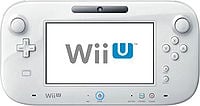Wii U GamePad: Difference between revisions
No edit summary |
Omega Tyrant (talk | contribs) (→In competitive play: The pressing issue with the Gamepad's rarity at the tournaments isn't its effectiveness as a controller, it's the fact tournaments outright banned it.) |
||
| Line 34: | Line 34: | ||
==In competitive play== | ==In competitive play== | ||
The Wii U GamePad is technically seen | The Wii U GamePad is technically seen in most {{Forwiiu}} tournaments due to the GamePad needing to be within a certain radius for the console to function properly, and so setups will often have one nearby. That being said, it is almost never actually used by players at tournaments. Aside from the GamePad's large and bulky build turning off most people from using it over other controller options, tournaments generally ban the GamePad from being used at all, since only one GamePad can by synced to a Wii U at a time. This means if two or more GamePad users were to face off in a match, only one would be able to use it, with no fair way to resolve who gets to use the GamePad. Additionally, an already synced GamePad cannot be unsynced without forcefully severing the connection by moving the GamePad too far away to maintain its connection or draining its battery, and the game would also have to be closed to resync a new GamePad, meaning GamePad users cannot switch to other setups without a complicated and time-consuming process, a fundamental requirement for a smooth tournament experience. Simply allowing GamePad users to use whatever GamePad is already synced to a Wii U would theoretically address this issue, but due to the GamePads being expensive and hard-to-replace, people who bring their setups to tournaments are generally unwilling to let other players use their GamePads, while the GamePad users are also liable to find another person's GamePad to be in suboptimal condition. | ||
{{Controller|notbutton=yes}} | {{Controller|notbutton=yes}} | ||
[[Category:Controllers]] | [[Category:Controllers]] | ||
[[Category:Wii U]] | [[Category:Wii U]] | ||
Revision as of 02:59, March 20, 2023
The Wii U GamePad is a controller for use with the Wii U console. In addition to standard controller capabilities, the GamePad includes a 6-inch touchscreen in the center. The Wii U GamePad is one of the many controllers that can be used to play Super Smash Bros. for Wii U. The GamePad's near field communication functionality is also required in order to use amiibo figurines with the game.
In addition to its standard usage as a controller, the GamePad's touchscreen is used for other functions in the game. As with many Wii U games, the GamePad can be used for Off-TV Play, where the second screen is used in conjunction with or in place of the TV for displaying the game. This means the entirety of Super Smash Bros. for Wii U can be played on the GamePad if the player desires. the GamePad screen can also be set to display the damage meters during a match instead of simply showing the same image as the TV screen. In Stage Builder, stages can be built by drawing the platforms using the touchscreen. The GamePad can also be used to draw on saved snapshots taken during matches, using a basic built-in painting tool.
The Wii U GamePad has latency comparable to a WaveBird GameCube controller, experiencing lows of 71.2ms (4.1 frames) and highs of 84.53ms (5.1 frames). It is more consistent by comparison, as the WaveBird often experiences higher latency in worse situations, being as high as 92.86ms (5.5 frames).
Standard Controls (Super Smash Bros. for Wii U)
| Move | |
| Standard attacks | |
| Special moves | |
| Stick-smash | |
| Jump | |
| Grab | |
| Shield | |
| Taunt | |
| Pause | |
| Home Menu | |
| Nothing |
In competitive play
The Wii U GamePad is technically seen in most Super Smash Bros. for Wii U tournaments due to the GamePad needing to be within a certain radius for the console to function properly, and so setups will often have one nearby. That being said, it is almost never actually used by players at tournaments. Aside from the GamePad's large and bulky build turning off most people from using it over other controller options, tournaments generally ban the GamePad from being used at all, since only one GamePad can by synced to a Wii U at a time. This means if two or more GamePad users were to face off in a match, only one would be able to use it, with no fair way to resolve who gets to use the GamePad. Additionally, an already synced GamePad cannot be unsynced without forcefully severing the connection by moving the GamePad too far away to maintain its connection or draining its battery, and the game would also have to be closed to resync a new GamePad, meaning GamePad users cannot switch to other setups without a complicated and time-consuming process, a fundamental requirement for a smooth tournament experience. Simply allowing GamePad users to use whatever GamePad is already synced to a Wii U would theoretically address this issue, but due to the GamePads being expensive and hard-to-replace, people who bring their setups to tournaments are generally unwilling to let other players use their GamePads, while the GamePad users are also liable to find another person's GamePad to be in suboptimal condition.
| Controllers and buttons | |
|---|---|
| Nintendo 64 controller | |
| GameCube controller | |
| Wii Remote (and Nunchuk) | |
| Classic Controller | L |
| Nintendo 3DS | |
| Wii U GamePad / Pro Controller | L |
| Joy-Con | |
| Switch Pro Controller | L |
| Third-party controllers | Hori Mini Pad · Arcade controller · Keyboard |
| Other | Smash Controller · Controller modification |
